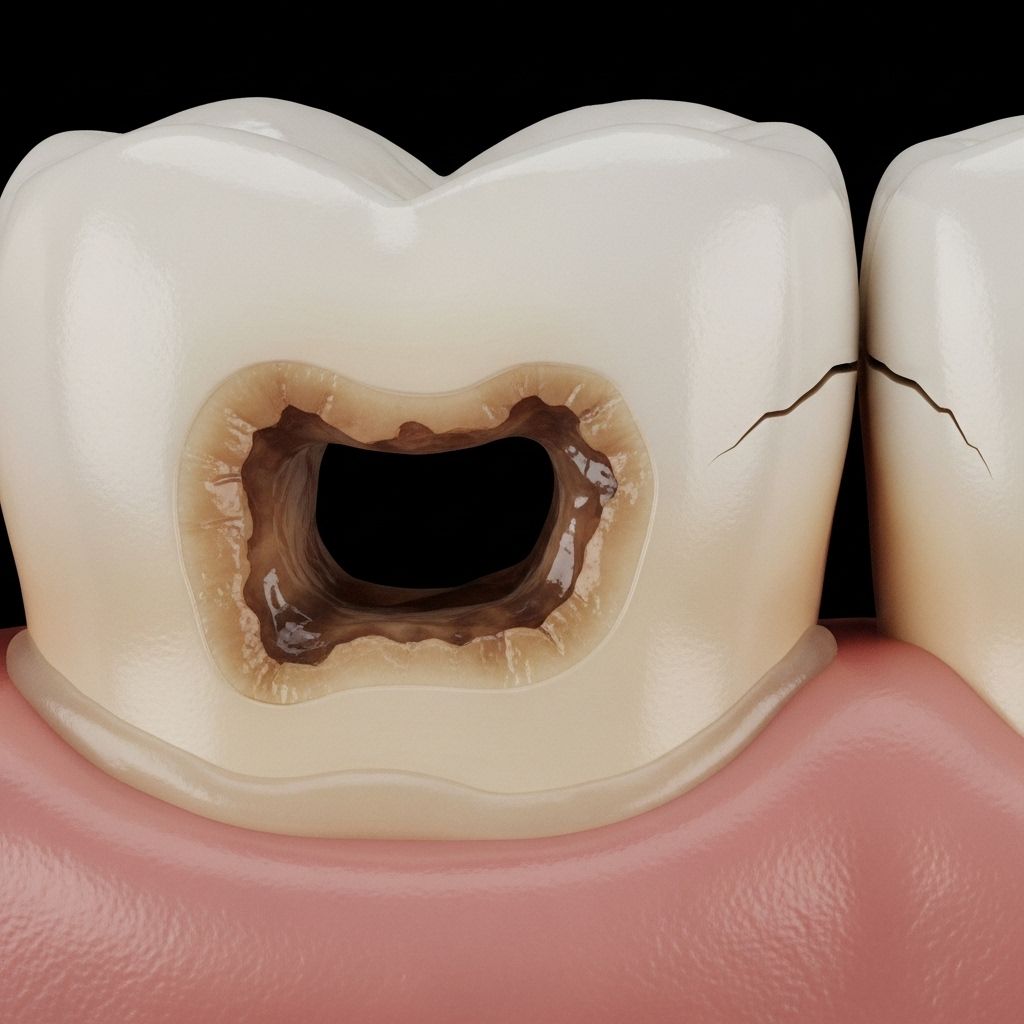Dental Cavities: Causes, Symptoms, Prevention, and Treatment
Learn about dental cavities—their causes, symptoms, diagnosis, treatment options, complications, and effective strategies for prevention.

Dental Cavities Overview
Dental cavities, also known as tooth decay or dental caries, are one of the most common health problems worldwide. They occur when acids produced by bacteria in dental plaque erode the tooth’s hard surfaces, leading to the formation of holes or lesions. Without prompt treatment, cavities can cause pain, infection, and even result in tooth loss.
Causes of Dental Cavities
The primary cause of dental cavities is a complicated interaction among bacteria, dietary sugars, and insufficient oral hygiene. The process begins with the formation of plaque, a sticky film composed of:
- Bacteria
- Saliva
- Food particles
- Acids
This plaque adheres tightly to tooth surfaces, especially in hard-to-reach areas. When you consume foods and drinks containing sugars or starches, the bacteria within plaque metabolize these carbohydrates and produce acid byproducts. These acids gradually erode the tooth’s outer layer, known as enamel, and can eventually reach deeper layers of the tooth.
Main Risk Factors
- Frequent consumption of sugary or sticky foods and beverages
- Poor oral hygiene practices
- Lack of regular dental care
- Dry mouth (reduced saliva flow)
- Medical conditions like diabetes
- Age (children, adolescents, and older adults are more susceptible)
- Social and economic factors (limited access to dental care and oral health education)
Symptoms of Dental Cavities
In its early stages, tooth decay often causes no symptoms. As decay progresses, the following symptoms may develop:
- Tooth pain or an achy feeling, especially after consuming sweet, hot, or cold foods and drinks
- Visible pits or holes in the teeth
- Tooth sensitivity to hot, cold, or sugary substances
- Brown, black, or white staining on tooth surfaces
- Bad breath or a persistent bad taste in the mouth
It is important to note that many cavities cause no pain until they become advanced, stressing the importance of regular dental checkups.
Exams and Tests
Dental cavities are typically identified during a routine dental examination, sometimes even before they cause symptoms. Dentists use several methods to detect cavities:
- Visual and tactile inspection to identify softened or damaged tooth surfaces
- Dental probes to detect soft spots on the enamel
- Dental X-rays to reveal cavities under the enamel and between teeth before they are visible to the naked eye
Early detection of cavities results in more effective and less invasive treatment.
Treatment of Dental Cavities
The goals of treating dental cavities are to remove decayed tissue, restore the tooth’s function, and prevent further damage. The recommended treatment varies based on the extent and location of decay:
Fillings
Dental fillings are the most common treatment for cavities. The procedure involves:
- Removing the decayed tooth material using a dental drill
- Filling the space with restorative materials such as composite resin, glass ionomer, or dental amalgam
Composite resin is preferred for its aesthetic results and durability, making it suitable for both front and back teeth.
Crowns
If tooth decay is extensive and compromises the overall structure, a crown (or cap) may be necessary. The procedure involves:
- Removing decayed or weakened portions of the tooth
- Repairing affected areas
- Placing a custom-made covering (crown), typically made from gold, porcelain, or porcelain fused to metal
Crowns provide strength and protection to teeth that have large fillings or are structurally weak.
Root Canal Therapy
When decay reaches the inner pulp (where nerves and blood vessels reside), a root canal becomes necessary. The steps include:
- Removing the infected or dead pulp tissue
- Cleaning and shaping the internal root canals
- Filling the canals with a sealing material called gutta percha
- Restoring the tooth, usually with a crown for strength and protection
Pain Management
If required, pain during dental procedures is managed with local anesthesia (e.g., lidocaine), nitrous oxide (laughing gas), or other medications. Patients with dental anxiety might benefit from nitrous oxide with anesthetics.
Outlook (Prognosis)
Most cases of tooth decay can be treated successfully, especially when caught early. Prompt intervention usually saves the tooth, is less painful, and often less expensive compared to managing advanced decay. Untreated cavities, however, can result in tooth loss and more serious complications.
Possible Complications
- Severe, persistent toothache
- Dental abscess (infection at the base of the tooth or gums)
- Spread of infection to surrounding tissues or other areas of the body
- Tooth loss
- Difficulty chewing or speaking
- Fractured or broken teeth
- Costly and complex dental treatments if decay is advanced
When to Contact a Dental Professional
- Contact your dentist promptly if you experience tooth pain, swelling, or other signs of infection
- Schedule regular dental checkups and cleaning at least every 6 to 12 months
Prevention of Dental Cavities
Prevention is the most effective approach to combating dental cavities. Good oral hygiene practices, dietary modifications, and routine dental care can greatly reduce your risk. Key preventive strategies include:
- Brush your teeth at least twice a day with fluoride toothpaste
- Floss at least once a day to remove plaque and food particles between teeth
- Visit your dentist for professional cleaning every 6 months
- Get regular dental X-rays, especially if at higher risk
- Use mouth rinses containing fluoride or antimicrobial agents if recommended
- Limit consumption of sticky or sugary foods and drinks
- Minimize snacking between meals
- Rinse your mouth with water after consuming sweets, dried fruits, or acidic beverages
- Chewy or sticky foods are better taken as part of meals rather than as standalone snacks
- Do not sip sugary drinks or suck on candies for prolonged periods
Dietary Factors and Cavity Risk
Diet plays a substantial role in cavity development. Frequent intake of processed sugars and carbohydrates fuels acid-producing bacteria. Individuals consuming sugary snacks or drinks, smoking, or consuming excessive alcohol are at higher risk. Social factors, including income and access to dental care, also influence cavity prevalence.
Who Is at Risk of Dental Cavities?
- Children and teenagers: Their teeth are more susceptible due to thinner enamel and varied hygiene habits.
- Older adults: Receding gums and worn dental work can expose tooth roots to decay.
- Individuals with chronic diseases (such as diabetes) or conditions causing dry mouth
- People with poor oral hygiene or limited access to dental services
- Individuals from lower income backgrounds, due to social and economic barriers to care
Frequently Asked Questions (FAQs)
Q: What causes dental cavities to form?
A: Dental cavities form when acids produced by bacteria erode the enamel, especially after frequent consumption of sugary foods, inadequate brushing, and insufficient flossing.
Q: What are the early symptoms of a cavity?
A: Early cavities may cause no symptoms, but as they progress, you may experience tooth sensitivity, pain with hot, cold or sweet foods, and visible holes or dark spots on your teeth.
Q: How are cavities diagnosed?
A: Dentists diagnose cavities during routine exams using visual inspection, dental probes to check tooth surfaces for softness, and dental X-rays to spot problems hidden beneath the surface or between teeth.
Q: What are the treatment options for dental cavities?
A: Common treatments include fillings, crowns for severe cases, and root canal therapy when decay reaches the tooth’s inner pulp. Early treatment can prevent further complications.
Q: How can I prevent cavities?
A: Practice good oral hygiene by brushing twice daily with fluoride toothpaste, flossing daily, reducing sugary foods and drinks, visiting your dentist regularly, and avoiding snacking between meals.
Dental Restorations: Comparison Table
| Restoration Type | Best For | Main Materials | Durability | Typical Location |
|---|---|---|---|---|
| Filling | Small to medium cavities | Composite resin, glass ionomer, amalgam | Moderate | Front and back teeth |
| Crown | Extensive decay or weakened tooth | Porcelain, gold, porcelain fused to metal | High | Any tooth, often molars |
| Root Canal + Crown | Decay reaching tooth pulp | Gutta percha (fill), crown material | High (with good oral hygiene) | Any tooth with severe decay |
Key Points to Remember
- Dental cavities are preventable with proper oral hygiene and dietary habits
- Treatment options depend on the extent of decay and include fillings, crowns, or root canals
- Early detection and intervention save time, cost, and discomfort
- Routine dental visits and professional cleaning are essential preventive measures
References
- Information reviewed and updated by dental and medical professionals as of March 31, 2024
- Sources: MedlinePlus Medical Encyclopedia, National Institutes of Health, and associated health professionals
References
- https://www.como.gov/Council/Commissions/downloadfile.php?id=8875
- https://medlineplus.gov/ency/article/001055.htm
- https://camaraethiopia.org.et/rachel/med/ency/article/001055.htm
- https://www.actiononsugar.org/sugar-and-health/sugars-and-tooth-decay/
- https://medlineplus.gov/toothdecay.html
- https://www.ncbi.nlm.nih.gov/books/NBK279514/
- https://www.listerine.com/cavities-strong-teeth/easy-cavity-prevention
- https://resources.healthgrades.com/right-care/oral-health/dental-caries
- https://healthlibrary.metroplus.org/HeartHealth/85,P00875
- https://medlineplus.gov/dentalhealth.html
Read full bio of medha deb












